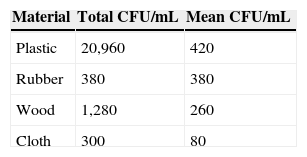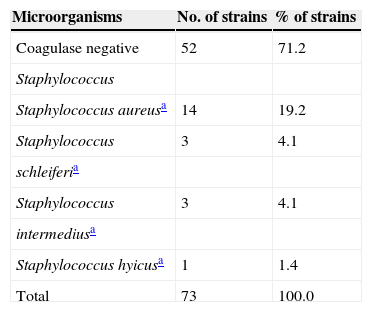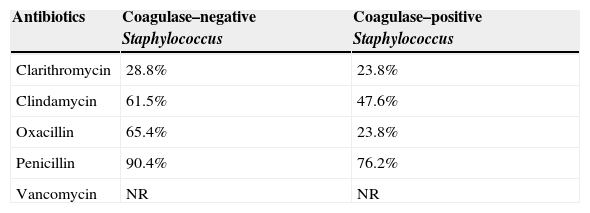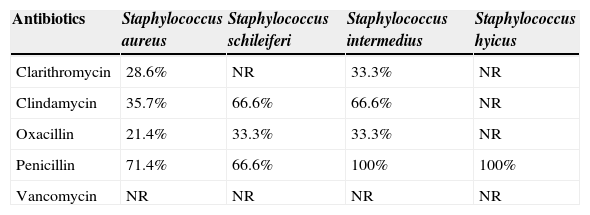To evaluate the presence of microorganisms of the genus Staphylococcus and Streptococcus on toys in the playroom of a teaching hospital, as well to as analyze the antimicrobial resistance from isolated strains.
MethodsSamples were collected from 60 toys, using wet swabs, soon after being used by the children. The samples were inoculated in enriched and selective agar for isolation and later identification of the microorganisms. Antibiogram testing was performed by agar diffusion technique.
ResultsThe genus Staphylococcus was present in 87.0% (52/60) of the toys. Seventy-three strains were isolated, with 29.0% (21/73) coagulase-positive and 71.0% (52/73) coagulase-negative. Among the coagulase-negative strains, 90.4% were resistant to penicillin, 65.4% to oxacillin, 28.8% to clarithromycin, 61.5% to clindamycin, and none to vancomycin. Among the coagulase-positive strains, 76.2% were resistant to penicillin, 23.8% to oxacillin, 23.8% to clarithromycin, 47.6% to clindamycin, and none to vancomycin. The genus Streptococcus was not detected in any of the evaluated toys.
ConclusionsToys can be contaminated with potentially pathogenic bacteria with antimicrobial resistance, representing a possible source of nosocomial infection for patients who are already debilitated.
Observar a presença de microrganismos dos gêneros Staphylococcus e Streptococcus em brinquedos de uma brinquedoteca de unidade pediátrica hospitalar, bem como analisar o perfil de resistência aos antimicrobianos das cepas isoladas.
MétodosForam realizadas coletas de 60 brinquedos, utilizando swab umedecido em solução fisiológica, logo após a utilização pelas crianças. As amostras coletadas foram semeadas em meios de cultura para proporcionar o isolamento dos microrganismos e posterior identificação. Foi realizado o antibiograma para todas as bactérias identificadas, com a técnica de difusão em agar.
ResultadosO gênero Staphylococcus estava presente em 87% (52/60) dos brinquedos analisados. Foram isoladas 73 cepas, sendo 29% (21/73) de Staphylococcus coagulase-positiva e 71% (52/73) de Staphylococcus coagulase-negativa. Neste estudo, 90,4% das cepas coagulase-negativas apresentaram resistência à penicilina, 65,4% à oxacilina, 28,8% à claritromicina, 61,5% à clindamicina e nenhuma à vancomicina. Das cepas coagulase-positivas, 76,2% apresentaram resistência à penicilina, 23,8% à oxacilina, 23,8% à claritromicina, 47,6% à clindamicina e nenhuma à vancomicina. Não foram detectadas bactérias do gênero Streptoccocus nos brinquedos estudados.
ConclusõesOs resultados obtidos demonstraram que os brinquedos podem apresentar contaminação por bactérias potencialmente patogênicas com resistência aos antimicrobianos, representando uma possível fonte de infecção nosocomial para pacientes que normalmente já se encontram debilitados.
It is through playing that children communicate with the en-vironment they live in, express feelings as love, anger, frustrations, and anxieties, as well as stimulate their fantasy and imagination, allowing them to understand reality.1 In hospital environments, playing can provide a less traumatic hospitalization and, therefore, establish better conditions for recovery.2 Posfay-Barbe et al3 demonstrated that, due to the immaturity of the immune system, children are more susceptible to infections when compared to adult patients. Moreover, hospitalized children are even more susceptible due to factors such as the underlying disease that led to hospitalization, invasive procedures, and medications, among others.
Sharing objects and toys among hospitalized children favors the cross-contamination process, which can increase disease transmission in this population.4,5 Several authors have demonstrated toy contamination by microorganisms from normal and potentially pathogenic microbiota. Some of these microorganisms can remain viable for hours and even weeks on surfaces when they are not properly cleaned and sanitized, and thus toys can function as a pathogen reservoir.6
In the hospital setting, multiresistant microorganisms may compromise the treatment of certain diseases.7 Some species present widespread resistance throughout the world, such as Staphylococcus aureus, while others maintain a remarkable sensitivity to active drugs, such as Streptococcus pyogenes. Strains of Staphylococcus epidermidis, S. saprophyticus, and S. haemolyticus, as well as other coagulase-negative Staphylococci most frequently identified in clinical practice have also started to demonstrate resistance to oxacillin and other related drugs.8
Considering the importance of toys as a therapeutic adjuvant for hospitalized children and, also, due to the possibility of their role as reservoirs of potentially pathogenic and multiresistant microorganisms, the aim of this study was to evaluate the presence of the Staphylococcus and Streptococcus bacteria in toys obtained from the playroom of a hospital pediatric unit, as well as to analyze the antimicrobial resistance profile of isolated strains.
MethodsThis was a descriptive study with a quantitative approach, developed in the playroom of the Pediatric Unit of Hospital Universitário de Taubaté (São Paulo, Brazil). The project was approved by the Research Ethics Committee of Universidade de Taubaté under protocol No. 081/11.
A survey was carried out on the available number of toys in the playroom, which showed the presence of 50 (83%) plastic, five (8%) wooden, one (2%) rubber, and four (7%) cloth toys. As the methodological design of this study allowed for the inclusion of all toys available in the hospital, sample size calculation was discarded and the sample group from the university hospital consisted of all toys found, totaling 60 units.
After the toys were used by the pediatric patients, sample collection was performed. For that purpose, swabs moistened in 1 mL of sterile saline solution were swabbed across the entire toy surface. The samples were homogenized and plated on mannitol-agar and blood-agar with novobiocin, and incubated at 37°C for 24 hours under aerobic conditions and in the presence of 5% CO2, respectively. After incubation, analysis was performed by observing the morphology of colonies and hemolysis patterns. The counting of colony-forming units (CFUs) was done and, subsequently, smear and Gram stain for observation of morphological and staining characteristics of bacterial cells were performed. The characteristic colonies of each microorganism were selected to obtain a pure culture.
After obtaining pure cultures of Gram-positive cocci, the catalase test was performed. The coagulase test was performed for the catalase-positive strains and, sequentially, the β-galactosidase test, the Voges-Proskauer (VP) test, and the trehalose test according to Koneman9 were performed for coagulase-positive strains. Coagulase-negative species were not identified.
Antibiograms, or antimicrobial disk susceptibility tests, were performed for all identified bacterial strains. For this purpose, the agar diffusion technique was utilized. The antimicrobial agents used were penicillin, oxacillin, clarithromycin, clindamycin, and vancomycin. The analysis was performed by measuring the zone of microbial growth inhibition in millimeters. The results were interpreted according to the rules of the National Committee for Clinical Laboratory Standards Institute (CLSI).10
ResultsNo bacteria of the Streptococcus genus were isolated from the studied toys. From the sample of 60 toys, 52 (87%) were positive for Staphylococcus bacteria, and plastic toys were the most contaminated, with a mean of 420 CFUs/mL of solution, followed by rubber toys, with 380 CFUs/mL, and wooden toys, with 260 CFUs/mL. Cloth toys showed less contamination (Table 1).
Among the Staphylococcus species, there was a higher prevalence of coagulase-negative Staphylococcus, followed by Staphylococcus aureus. Other coagulase-positive species were also isolated, but to a lesser degree (Table 2).
Percentage of Staphylococcus strains isolated from toys obtained from a teaching hospital playroom
Staphylococcus bacteria isolated in this study were resistant to most tested antibiotics. The resistance profile of the isolated strains is shown in Table 3.
Resistance profile of Staphylococcus bacteria isolated from toys obtained from a teaching hospital playroom, described in percentage (%)
| Antibiotics | Coagulase–negative Staphylococcus | Coagulase–positive Staphylococcus |
|---|---|---|
| Clarithromycin | 28.8% | 23.8% |
| Clindamycin | 61.5% | 47.6% |
| Oxacillin | 65.4% | 23.8% |
| Penicillin | 90.4% | 76.2% |
| Vancomycin | NR | NR |
NR, not resistant
The drug resistance profile in relation to the Staphylococcus species is shown in Table 4. No strain showed sensitivity to all antimicrobials, and all tested strains were sensitive to vancomycin.
Resistance profile of coagulase–positive Staphylococcus bacteria isolated from toys obtained from a teaching hospital playroom, described in percentage (%)
| Antibiotics | Staphylococcus aureus | Staphylococcus schileiferi | Staphylococcus intermedius | Staphylococcus hyicus |
|---|---|---|---|---|
| Clarithromycin | 28.6% | NR | 33.3% | NR |
| Clindamycin | 35.7% | 66.6% | 66.6% | NR |
| Oxacillin | 21.4% | 33.3% | 33.3% | NR |
| Penicillin | 71.4% | 66.6% | 100% | 100% |
| Vancomycin | NR | NR | NR | NR |
NR, not resistant
Several species of bacteria of the Streptococcus genus are of great medical importance due to the development of severe infectious processes, such as pneumonia, meningitis, and septicemia. The nasopharyngeal carrier state is common, especially in the colder months and in children, allowing for the contamination of the environment and toys shared by children.
Davis et al,11 when analyzing bacterial contamination in ball pools of restaurants after collecting a sample from the pools and in several areas of the pool floor material, observed that Streptococcus spp. was found in 47.2% of samples. Freitas et al12 collected 30 samples from ten different hard plastic toys (triplicate) for six weeks in the playroom of a charity hospital, and isolated Streptococcus sanguis in only 0.8% of them.
Although the methodology used in both aforementioned studies was similar to that used in the present study, no Streptococcus bacteria were found in the evaluated playroom, probably due to their small potential for survival in the environment.
A high percentage of microbial contamination by Staphylococcus bacteria was observed in the toys analyzed in this study, with the highest prevalence of coagulase-negative species (71.2%). Coagulase-negative Staphylococcus bacteria are part of the resident skin microbiota, and the most common are S. epidermidis, S. hominis, and S. saprophyticus.13 They are not considered to be pathogens, but infectious processes associated with these microorganisms have been increasingly identified.
The results of the present study are in agreement with Davis et al,12 who also found a high percentage of S. epidermidis (73.0%), a coagulase-negative species, in ball pools. Avila Aguero et al14 evaluated whether the toys had already been infected when they were delivered to the hospital or if they were contaminated within the hospital environment. The authors observed a prevalence of 45.5% (77/169) of coagulase-negative Staphylococcus in hospital toys. Freitas et al12 reported lower percentages of these staphylococci (38.8%) in playroom toys.
The toy material certainly influences contamination. In the present study, plastic toys showed the highest level of contamination. These results are in agreement with the studies by Avila Aguero et al,14 who also found higher bacterial contamination in plastic toys (75%; 92/122), followed by metal toys (16%; 20/122), and other materials (9%; 10/122).
Coagulase-positive Staphylococcus were also found in the toys analyzed in the present study (28.8%), with S. aureus as the most prevalent species, followed by S. schleiferi, S. intermedius, and S. hyicus. S. aureus can colonize the nasal mucosa, and its' colonization prevalence in the general population is around 20% to 40%.15 Therefore, the finding of these microorganisms in toys handled by children admitted to the hospital was expected. In normal skin, S. aureus is rare (less than 10%), although it is the main aerobic bacteria found in eczematous lesions. In atopic individuals, it is found in approximately 90% of the eczematous areas, and in approximately 70% of healthy skin.13
As for the other coagulase-positive species of the Staphylococcus genus, although some are more often considered animal pathogens, they can also infect humans in addition to having enterotoxigenic capacity, especially S. hyicus and S. intermedius, as described in food poisoning outbreaks.16–18
Currently in Brazil, over 80% of S. aureus isolates from hospitalized patients and 70% of isolates from patients in the community are resistant to natural penicillins and, by extension, to ampicillin and amoxicillin.19–21 According to Moreira and Daum,22 in virtually every part of the world, community-acquired coagulase-positive or negative Staphylococcus spp. present high resistance to benzyl penicillin (penicillin G), as well as to penicillin V, ampicillin, amoxicillin, and carbenicillin; these antibiotics are no longer being suitable for use in treatment of staphylococcal infections, even when they are benign and originate in the extra-hospital environment. Indeed, in the present study, penicillin resistance found among coagulase-positive Staphylococcus, most of them S. aureus, was 76.2%.
According to Schwalb et al23 and Moreira and Daum,22Staphylococcus spp. bacteria have also shown increasing resistance to penicillinase-resistant beta-lactams, showing rates as high as 30% to 66%, notably in large hospitals with emergency services open to the public and referral centers for infected patients.
In 1988, in Rio de Janeiro, oxacillin resistance was 27% among strains of S. aureus isolates in Gaffrée and Guinle hospital (without emergency service), while in Souza Aguiar hospital (one of the largest emergency services of the city) resistance was 58%.24,25 In the study by Bernardes et al,26 who analyzed strains of coagulase-positive Staphylococcus isolates from hospitalized patients in three different hospitals, the results of oxacillin resistance were: 59.2% in hospital 1, 63.2% in the hospital 2, and 85.7% hospital 3. In the present study, the resistance of coagulase-positive Staphylococcus to oxacillin was only 23.8%.
These variations are certainly due to differences related to the method and location of collection, and although the percentage found was small when compared to other reports in literature, the presence of these microorganisms should not be neglected.
The strains of Staphylococcus aureus showed less resistance to antimicrobials, to penicillin (71.4%), as well as to oxacillin (21.4%) and clindamycin (35.7%), compared to other coagulase-positive strains, whereas the S. intermedius and S. hyicus showed 100% resistance to penicillin and none to oxacillin and clindamycin. In spite of the resistance profile obtained in this study, it is known that S. aureus is one of the main bacterial pathogens causing clinical infections, and it is also involved in food poisoning cases.27
Among the coagulase-negative bacteria, the observed resistance was higher for penicillin (90.4%), as well as for oxacillin (65.4%) and clindamycin (61.5%). Ávila Agüero et al14 also found high resistance to oxacillin (58%) in coagulase-negative Staphylococcus isolates. Freitas et al12 observed that these organisms showed 87.2% resistance to penicillin G and 40.4% to erythromycin. However, oxacillin resistance reported by the authors was 4.6% and to clindamycin, 17%.
To prevent the transmission of microorganisms through contaminated toys, a cleaning routine should be adopted as those observed in other hospital areas. For this purpose, toys whose composition allows for cleaning with soap and water (plastic, rubber, acrylic, and metal), which are nontoxic and can be disinfected with 70% alcohol without damages, should be chosen.5
It should also be remembered that toys need to be kept in boxes made of washable materials with covers, or in cabinets, which also require regular and effective cleaning. In this context, it is of utmost importance that health professionals pay special attention to disinfection of toys, as playing is part of the children's rights assured by the Statute of Children and Adolescents.28 The integrated work of the multidisciplinary healthcare team of the pediatric unit, the playroom team, and the hospital infection control service staff is the basis for adherence to the practices for prevention and control of infections disseminated by contaminated toys.1
Thus, it is concluded that potentially pathogenic and multidrug resistant microorganisms can be found in toys from a teaching hospital playroom, which may be considered agents of cross-infection. Coagulase-negative Staphylococcus was the most prevalent organism in toys, and showed higher resistance to tested antibiotics, when compared to coagulase-positive Staphylococcus. All strains were susceptible to the antibiotic vancomycin.
FundingScholarship of Scientific Initiation Program/Universidade de Taubaté, process number 088/10 IBB.
Conflicts of interestThe authors declare no conflicts of interest.
The authors would like to thank the microbiology laboratory at Universidade de Taubaté, which provided space and materials for the research; and Universidade de Taubaté, for their research incentive and the scholarship of Scientific Initiation Program that funded this project.








